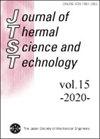Formulation of steady-state void fraction through the principle of minimum entropy production
IF 0.9
4区 工程技术
Q3 THERMODYNAMICS
引用次数: 5
Abstract
The complexity of the actual operation of thermal engineering systems comprises multiphase interfacial phenomena evolving out of equilibrium. Therefore, their generalised formulation can contribute towards better understanding and control of these phenomena, eventually pushing the existing related technologies beyond the state-of-the-art. In this respect, variational principles are significant for a more comprehensive physical representation and for closing the problem, while obtaining relatively simpler mathematical formulations. In this study, a general variational formulation of dissipative two-phase flows based on the minimum entropy production is developed. In particular, this study provides a general expression of the entropy generation rate, which introduces interfacial contributions due to surface tension between different phases, and is used to estimate two-phase flow fraction based on Prigogine's theorem of minimum entropy generation. Subsequently, this formulation is investigated in terms of different assumptions and pressure drop models, and employed to clarify the implementation of Prigogine's theorem to obtain the widely-accepted Zivi's expression of void fraction and the effect of different assumptions on the deviation from his expression. A new expression is finally obtained to cover laminar flow conditions, which are implicitly excluded from the applicability of Zivi’s expression.用最小熵产生原理计算稳态空穴分数
热工系统实际运行的复杂性包括多相界面现象的演化。因此,它们的广义公式有助于更好地理解和控制这些现象,最终推动现有的相关技术超越最先进的水平。在这方面,变分原理对于更全面的物理表示和解决问题具有重要意义,同时获得相对简单的数学公式。本文提出了基于最小熵产生的耗散两相流的一般变分公式。特别是,本研究提供了熵生成率的一般表达式,该表达式引入了不同相之间表面张力对界面的贡献,并基于Prigogine最小熵生成定理用于估计两相流分数。随后,对该公式进行了不同假设和压降模型的研究,并阐明了Prigogine定理的实现,得到了被广泛接受的空隙率的Zivi表达式以及不同假设对其表达式偏差的影响。最后得到了一个新的表达式,涵盖了在Zivi表达式的适用性中隐含排除的层流条件。
本文章由计算机程序翻译,如有差异,请以英文原文为准。
求助全文
约1分钟内获得全文
求助全文
来源期刊
CiteScore
2.30
自引率
8.30%
发文量
0
审稿时长
5 months
期刊介绍:
JTST covers a variety of fields in thermal engineering including heat and mass transfer, thermodynamics, combustion, bio-heat transfer, micro- and macro-scale transport phenomena and practical thermal problems in industrial applications.

 求助内容:
求助内容: 应助结果提醒方式:
应助结果提醒方式:


